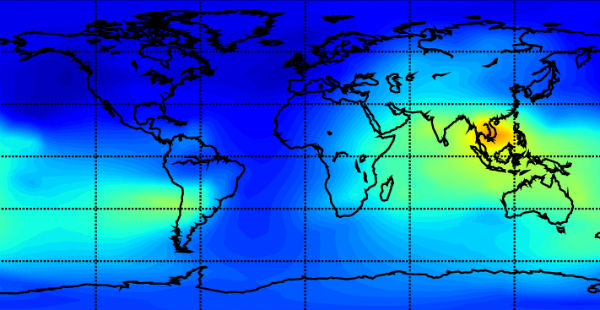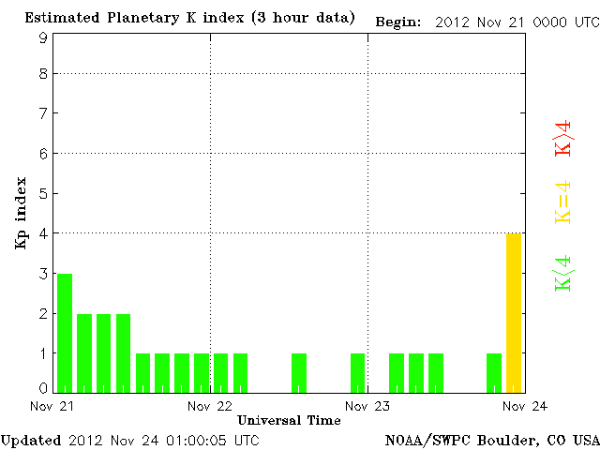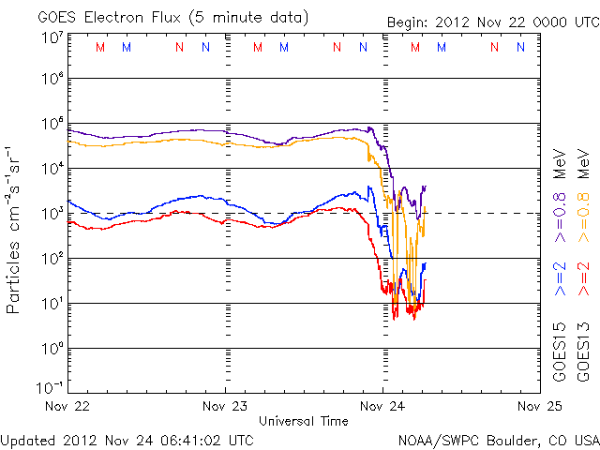Geomagnetic storm in progress, Aurora at high latitudes

The passage of an interplanetary shock (CME) was recorded at 21:56 UTC on November 23, 2012. ACE spacecraft measured a geomagnetic sudden impulse of 25nT. The maximum southward component of Bz was -8.8 nT at 21:12 UTC on November 23. The primary Coronal Mass Ejection (CME) responsible for this storming was associated with a solar flare from NOAA Region 1618 that peaked at the R1 (Minor) level on November 21 at 15:30 UTC. NOAA/SWPC issued a Warning of expected geomagnetic K-index of 5 or Minor G1 geomagnetic storm.
Space Weather Message Code: SUMSUD
Serial Number: 164
Issue Time: 2012 Nov 23 2201 UTCSUMMARY: Geomagnetic Sudden Impulse
Observed: 2012 Nov 23 2156 UTC
Deviation: 25 nT
Station: BOU***
Space Weather Message Code: WARK05
Serial Number: 818
Issue Time: 2012 Nov 23 2246 UTCWARNING: Geomagnetic K-index of 5 expected
Valid From: 2012 Nov 23 2300 UTC
Valid To: 2012 Nov 24 1100 UTC
Warning Condition: Onset
NOAA Scale: G1 – Minor
Potential Impacts: Area of impact primarily poleward of 60 degrees Geomagnetic Latitude.
Induced Currents – Weak power grid fluctuations can occur.
Spacecraft – Minor impact on satellite operations possible.
Aurora – Aurora may be visible at high latitudes, i.e., northern tier of the U.S. such as northern Michigan and Maine.
The greater than 2 MeV electron flux at geosynchronous orbit reached a maximum of 1408 pfu. According to NOAA/SWPC report, geomagnetic field activity is expected to begin at active levels and reach major storm levels early on November 24 with the effects from the November 20 CME coupled with the anticipated arrival of the November 21 CME. On day two (25 Nov), conditions are expected to return to unsettled to active levels due to residual CME effects combined with a coronal hole high-speed stream. The unsettled levels may persist into day three (26 November).
A long filament in the south-east of the solar disc erupted today creating an Earth directed CME, seen first at 13:54 UTC by COR2 on STEREO Ahead and at 14:10 UTC on STEREO-B with a calculated speed of 533 km/s. An arrival and corresponding geomagnetic storm at Earth can be expected on November 26. Although most of the plasma cloud is heading south,some portion of the cloud may be Earth directed.
The largest solar event of the period was registered as C1 event observed at 12:12 UTC from Region 1618. Although this region retained its beta-gamma-delta magnetic characteristics, it experienced intermediate penumbral decay. All other regions on the disk remained stable and quiet.
The subsequent CME was observed in STEREO-A and B COR2 imagery around 14:00 UTC on November 23. Using geometric localization, a preliminary speed of approximately 550 km/s was obtained. This suggests an arrival at Earth early on 27 November.
CURRENT CONDITIONS:
Solar wind
speed: 409.4 km/sec
density: 12.0 protons/cm3
The Radio Sun
10.7 cm flux: 128 sfu
Planetary K-index
Now: Kp= 4 unsettled
24-hr max: Kp= 4 unsettled
Interplanetary Mag. Field
Btotal: 12.5 nT
Bz: 6.4 nT south



[…] https://watchers.news/2012/11/24/geomagnetic-storm-in-progress-aurora-at-high-latitudes/ Share this:PrintFacebookEmailTwitterStumbleUponRedditDiggLinkedInGoogle +1Like this:LikeBe the first to like this. By AscendingStarseed • Posted in Space Weather Affecting Earth • Tagged Aurora, coronal mass ejection, Earth's magnetic field, Geomagnetic storm, space weather 0 […]
It would truly be appreciated if some reference could be given for abreviations used. Some can be googled such as nt (nanotesla) but what is Bz?
Or do you only intend your articles for graduate scientists?
Hey Martin! We wrote many times about Bz component. You’re right that not so many peple really understand what it means. It makes no sense to write about these components every time, but thanks for observation. We will work it out the best way to bring info to all our readers. Occasionally we write articles explaining the solar components and facts about solar activity and solar observation, so you can search through our archives for what ever you are interested in. Anyway, more info about interplanetary magnetic field and it’s components can be found here: http://pluto.space.swri.edu/image/glossary/IMF.html and here: http://spaceweather.com/glossary/imf.html and here: http://www.gmw.com/technicalnotes/magfield_vectors.html